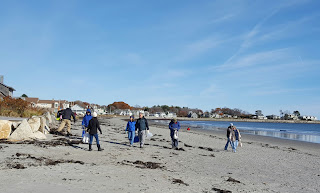Microplastics sampling season is just around the corner but here is a quick recap of what we found out last year. The 2015 season was highly impacted by weather and a lot of recreational traffic on many of the beaches in the summer (not surprising, but frustrating!). We sampled five of NH's most loved beaches, Hampton Beach, Jenness Beach, Wallis Sands, North Hampton State Beach and Hampton Harbor beach from May until September.
During the 5 months of sampling we found the overall average concentration / beach was:
| Beach |
Overall AVG Microplastics
concentration pieces/m3 |
| Jenness |
3090 |
| Wallis Sands |
2890 |
| Hampton Harbor |
1762 |
| Hampton Beach |
1660 |
| North Hampton |
500 |
The seven main categories of microplastics found in samples were:
- Pellets (pre- fabricated nurdles)
- Fragments
- Whole Pieces
- Foams
- Films
- Filaments
- Cigarette Parts
As with the previous year, the predominant types of microplastics found on these beaches were fragments and foams, although on Jenness Beach, prefabricated nurdles were the predominant type of microplastic found.
Along with collecting some interesting and sometimes unexpected data (such as the low concentrations of microplastics on Hampton Beach and the high concentration of nurdles on Jenness), in the years since we started sampling for microplastics we have also learned some valuable lessons which we hope will make sampling this year go more smoothly:
1)
Do not try to sample all of NH 's beaches: NH Beaches are all very different with regard to topography, sand type, usage and most importantly, accessibility. We quickly realized that even though we originally set out to sample 12 beaches, that this would not be possible because some beaches were too rocky and others, because of the parking and residence restrictions, were nearly impossible to access. We have since narrowed our scope and try and sample 5-6 beaches once a month from April- October.
2)
Keep it Simple: Since we depend on our volunteers, realizing that they are giving up their time to help out means that we needed to streamline our protocols and make this project as simple as possible.
3)
Sampling doesn't always go as planned: The ideal sampling session is a beautiful day- 75 degrees, sunny, no wind and dry, dry, dry sand that can go through sieves easily, no parking issues and few people on the beach. These days happen, but when they don't it makes sampling frustrating and we need to adjust. If the sand is too wet, we either reschedule or we bag up the samples and dry them at UNH (or usually, my basement), if there are too many people, you have to reschedule (why summer sampling needs to happen in the early morning or the late afternoon) and if it is cold, overcast or windy, you just have to dress warmly and work quickly and efficiently. If the day is not ideal, plan to sample, but realize it could be rescheduled.
4)
Many hands make easy work: This is where volunteers come in. Without our volunteers, this project, as fun, interesting and IMPORTANT, as it is, could not happen with the help of volunteers. The more we have, the better. On days when we have 6-8 volunteers, we can do a beach in 1.5 hours. When I sample alone, it can take closer to 2.5 hours. So please, sign up and volunteer and bring a friend!
This year, with the early onset of spring and the lack of snow on the beaches, we start sampling on
April 11th! We have reduced the number of beaches from 12 to 6, and all beaches are readily accessible. Our protocols have been streamlined as best as possible and we hope to just do quick trainings on the days we sample. We plan on sampling every month beginning in April and ending in October. We also hope to have a few sorting sessions throughout so we can be all wrapped up by November.
Here is the schedule for April- again- we hope for perfect days, but we also realize that we may have to reschedule in case of weather.
- Mon 4/11- 10 AM:Hampton Beach
- Tues 4/12-10 AM: Wallis Sands State Beach
- Thurs 4/14-1 PM- Jenness Beach
- Fri 4/15-1 PM- North Hampton State Beach
- Mon 4/18- 3:30 PM-Seabrook Beach
- Tues 4/19-4 PM- Hampton Harbor
Please join us! We would love to have you! To join us, fill out a
volunteer application and e-mail it to Jen Kennedy at jen (at) blueoceansociety.org!
See you on the beach!
 |
| Microplastics hashtags in the sand : #nhmarinedebris, #plasticisforever, #findthenurdle |












